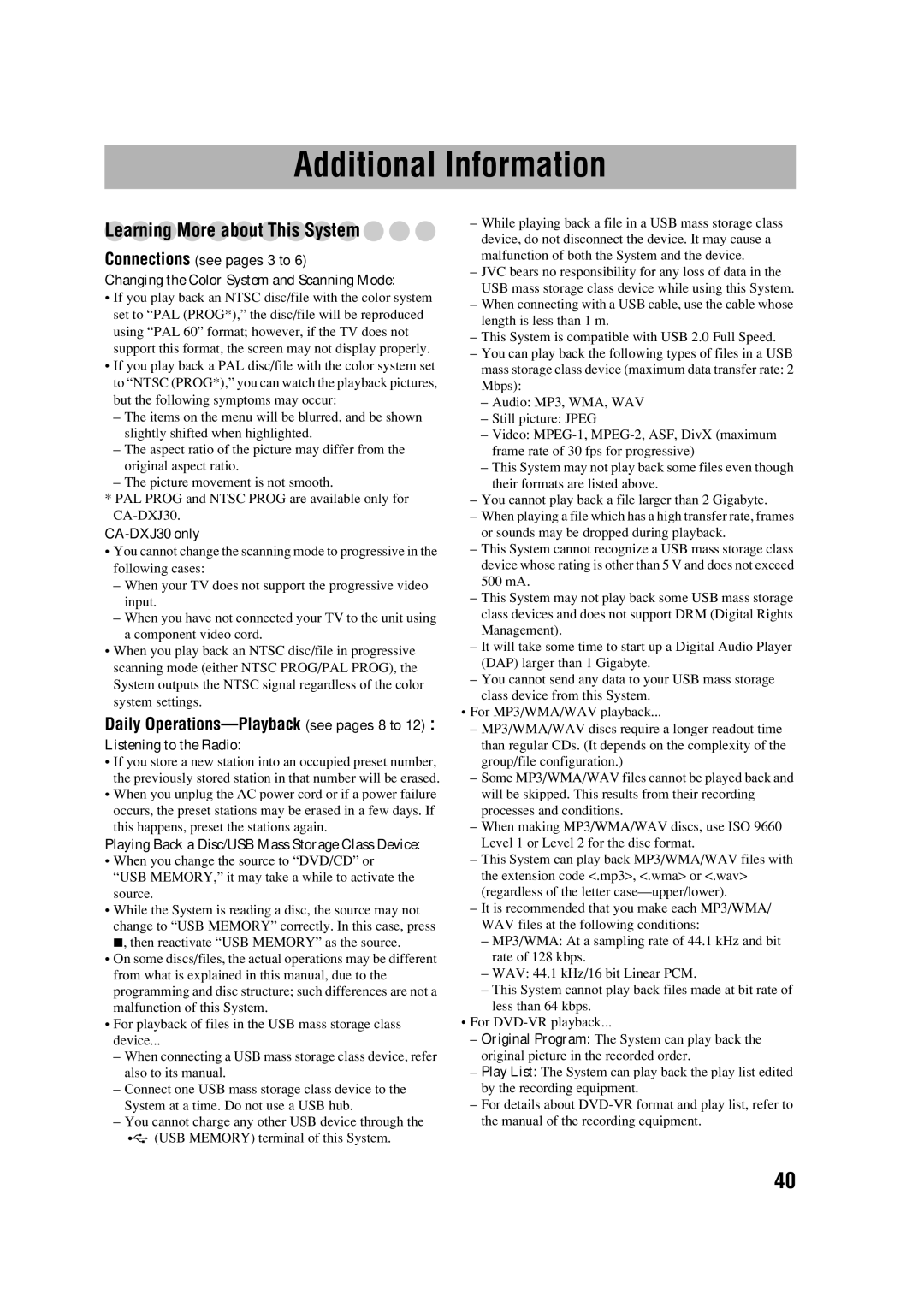
Additional Information
Learning More about This System 


Connections (see pages 3 to 6)
Changing the Color System and Scanning Mode:
•If you play back an NTSC disc/file with the color system set to “PAL (PROG*),” the disc/file will be reproduced using “PAL 60” format; however, if the TV does not support this format, the screen may not display properly.
•If you play back a PAL disc/file with the color system set to “NTSC (PROG*),” you can watch the playback pictures, but the following symptoms may occur:
–The items on the menu will be blurred, and be shown slightly shifted when highlighted.
–The aspect ratio of the picture may differ from the original aspect ratio.
–The picture movement is not smooth.
*PAL PROG and NTSC PROG are available only for
CA-DXJ30 only
•You cannot change the scanning mode to progressive in the following cases:
–When your TV does not support the progressive video input.
–When you have not connected your TV to the unit using a component video cord.
•When you play back an NTSC disc/file in progressive scanning mode (either NTSC PROG/PAL PROG), the System outputs the NTSC signal regardless of the color system settings.
Daily Operations—Playback (see pages 8 to 12):
Listening to the Radio:
•If you store a new station into an occupied preset number, the previously stored station in that number will be erased.
•When you unplug the AC power cord or if a power failure occurs, the preset stations may be erased in a few days. If this happens, preset the stations again.
Playing Back a Disc/USB Mass Storage Class Device:
•When you change the source to “DVD/CD” or
“USB MEMORY,” it may take a while to activate the source.
•While the System is reading a disc, the source may not change to “USB MEMORY” correctly. In this case, press 7, then reactivate “USB MEMORY” as the source.
•On some discs/files, the actual operations may be different from what is explained in this manual, due to the programming and disc structure; such differences are not a malfunction of this System.
•For playback of files in the USB mass storage class device...
–When connecting a USB mass storage class device, refer also to its manual.
–Connect one USB mass storage class device to the System at a time. Do not use a USB hub.
–You cannot charge any other USB device through the
![]() (USB MEMORY) terminal of this System.
(USB MEMORY) terminal of this System.
–While playing back a file in a USB mass storage class device, do not disconnect the device. It may cause a malfunction of both the System and the device.
–JVC bears no responsibility for any loss of data in the USB mass storage class device while using this System.
–When connecting with a USB cable, use the cable whose length is less than 1 m.
–This System is compatible with USB 2.0 Full Speed.
–You can play back the following types of files in a USB mass storage class device (maximum data transfer rate: 2 Mbps):
–Audio: MP3, WMA, WAV
–Still picture: JPEG
–Video:
–This System may not play back some files even though their formats are listed above.
–You cannot play back a file larger than 2 Gigabyte.
–When playing a file which has a high transfer rate, frames or sounds may be dropped during playback.
–This System cannot recognize a USB mass storage class device whose rating is other than 5 V and does not exceed 500 mA.
–This System may not play back some USB mass storage class devices and does not support DRM (Digital Rights Management).
–It will take some time to start up a Digital Audio Player (DAP) larger than 1 Gigabyte.
–You cannot send any data to your USB mass storage class device from this System.
•For MP3/WMA/WAV playback...
–MP3/WMA/WAV discs require a longer readout time than regular CDs. (It depends on the complexity of the group/file configuration.)
–Some MP3/WMA/WAV files cannot be played back and will be skipped. This results from their recording processes and conditions.
–When making MP3/WMA/WAV discs, use ISO 9660 Level 1 or Level 2 for the disc format.
–This System can play back MP3/WMA/WAV files with the extension code <.mp3>, <.wma> or <.wav> (regardless of the letter
–It is recommended that you make each MP3/WMA/ WAV files at the following conditions:
–MP3/WMA: At a sampling rate of 44.1 kHz and bit rate of 128 kbps.
–WAV: 44.1 kHz/16 bit Linear PCM.
–This System cannot play back files made at bit rate of less than 64 kbps.
•For
–Original Program: The System can play back the original picture in the recorded order.
–Play List: The System can play back the play list edited by the recording equipment.
–For details about
40
